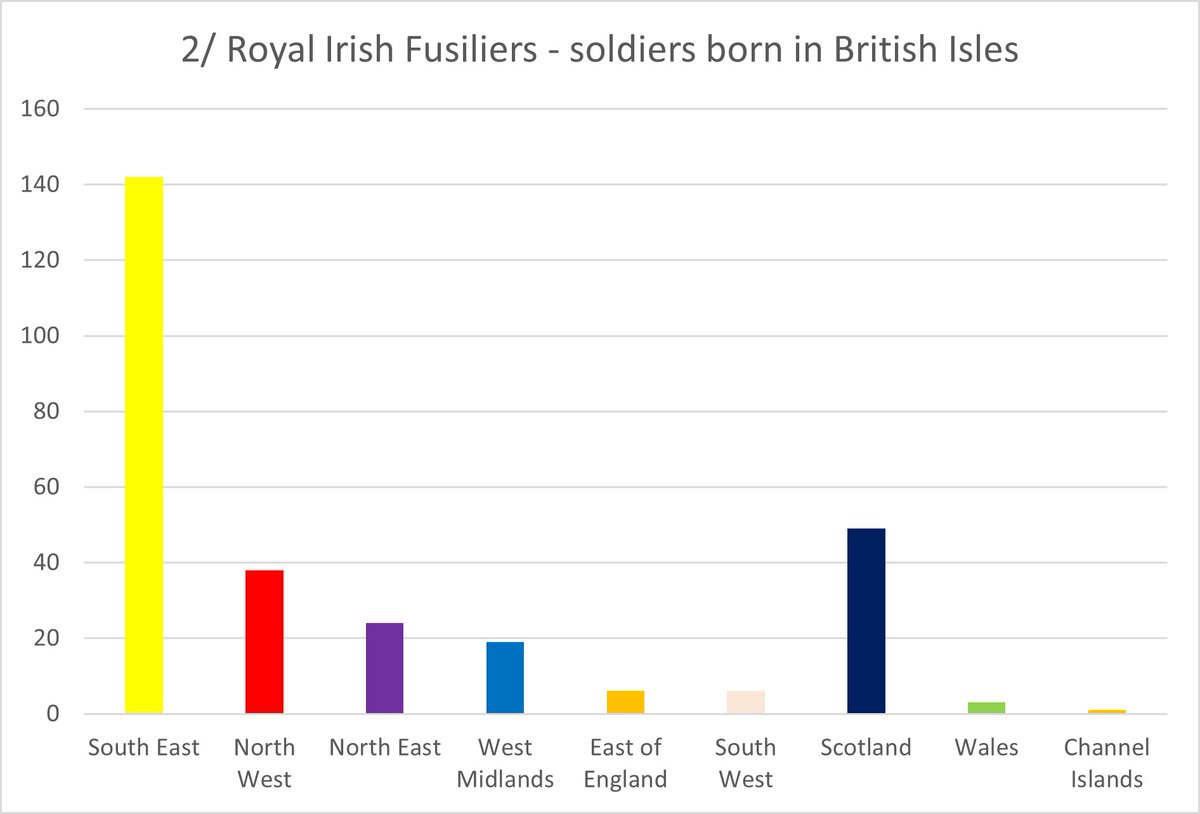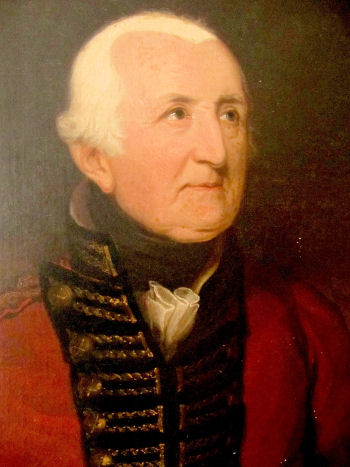
Welcome back to Day 3 of #BattalionCensus week!
As I slowly melt at my laptop, I look forward to sharing with you the history of the Royal Irish Fusiliers and hopefully provide an insight into the regiment at the time of the 1911 Census.
(NAM 2004-11-122-5)
1/
As I slowly melt at my laptop, I look forward to sharing with you the history of the Royal Irish Fusiliers and hopefully provide an insight into the regiment at the time of the 1911 Census.
(NAM 2004-11-122-5)
1/

2/ The history of the Royal Irish Fusiliers begins with the rapid (and necessary) expansion of the British Army in the early years of the French Revolutionary War. In September 1793 a regiment was raised in Ireland by General Sir John Doyle. The regiment was titled as the… 

3/…87th “The Prince of Wales’s Irish” Regiment. Two months later another unit was raised in Dublin by General William Crosbie and titled the 89th Regiment of Foot. Both regiments served in Flanders, with the 87th having the misfortune of being captured at Bergen Op Zoom in 1795. 

4/ The 89th returned to Ireland where it served during the 1798 Rebellion. The regiment went on to serve in the Mediterranean at Minorca, Sicily and Malta, later joining the Egyptian campaign. The 87th was re-raised and served in the West Indies from 1796-1804.
(NAM 1969-02-8-1)
(NAM 1969-02-8-1)

5/ With the failure of the Treaty of Amiens both regiments raised 2nd battalions in 1804. 1/89th served in Cathcart’s expedition to Hanover, but suffered disaster when two companies (and the battalion’s colours) were lost at sea.
(1st Earl Cathcart, by Gainsborough)
(1st Earl Cathcart, by Gainsborough)

6/ Both 1/87th & 1/89th (with new colours) took part in the abortive expedition to South America (the Battle of Buenos Aires pictured). They were subsequently dispatched to the Cape of Good Hope in 1807, and served during the capture of Mauritius in 1810.
(NAM 1971-02-33-88-1)
(NAM 1971-02-33-88-1)

7/ The 1/89th went on to serve in Java (1811) & Sumatra (1812), and by 1815 both regiments were stationed in India.
2/89th was part of the Irish garrison until 1810. Four companies served briefly in Spain but were captured during the abortive attack on Fuengirola in 1810.
2/89th was part of the Irish garrison until 1810. Four companies served briefly in Spain but were captured during the abortive attack on Fuengirola in 1810.
8/ The remaining companies of 2/89th fought throughout the War of 1812, winning the battle honour ‘Niagara’.
2/87th famously served throughout the Peninsular Campaign, fighting in many of its key battles and capturing a French Eagle at Barrosa in 1811.
(NAM 1971-02-33-533-33)
2/87th famously served throughout the Peninsular Campaign, fighting in many of its key battles and capturing a French Eagle at Barrosa in 1811.
(NAM 1971-02-33-533-33)

9/ Both regiments were reduced to a single battalion by 1816 and continued to serve in India. The 87th served in the Anglo-Nepalese War, the 89th during the Third Maratha War, with both regiments taking part in the First Anglo-Burmese War.
(British Library P156)
(British Library P156)

10/ In 1827, the 87th were retitled the 87th Regiment of Foot (Prince of Wales's Own Irish Fusiliers) although the title ‘Prince of Wales’ was dropped later that year. In 1833 the 89th were presented with new Colours by the then Princess Victoria, adding her coronet to its badge.
11/ Throughout the early 19th century both regiments were stationed in various posts across the globe. The 89th saw action during the Crimean War (pictured) and against the Xhosa in South Africa, before joining the 87th in India during the Indian Mutiny.
(NAM 1964-12-151-6-29)
(NAM 1964-12-151-6-29)

12/ The onset of the Cardwell Reforms of the 1870s saw single-battalion regiments, such as the 87th & 89th, linked together to share a depot and recruiting district. The 87th was linked to the 88th Foot in Galway, with the 89th linked with the 94th Foot in Armagh.
(IWM H 8539)
(IWM H 8539)

13/ Unlike many such pairings, the regiments were ‘split’ from their paired battalions during the 1881 Childers Reforms. As a result, the 87th & 89th amalgamated to become (respectively) the 1st & 2nd battalions of The Royal Irish Fusiliers (Princess Victoria's). 

14/ The new regiment became the ‘county regiment’ for Armagh, Monaghan and Cavan (all located within the province of Ulster) with its depot at Gough Barracks in Armagh. Curiously, the 88th and 94th regiments were amalgamated to form the Connaught Rangers (more on this tomorrow).
15/ The 1st Battalion was soon in action during the Anglo-Egyptian Campaign in 1882. In 1883, it moved to India, replacing the 2nd Battalion who returned to Britain in 1884 (via the Sudan) where they fought at El Teb and Tamai (pictured). The 1st Battalion…
(NAM 1963-11-5-1)
(NAM 1963-11-5-1)

16/…sent detachments to the Gold Coast in 1895 and to the Sudan in 1898, with both battalions seeing active service during the 2nd Boer War. The 2nd Battalion redeployed to India in 1903 and were stationed in Quetta at the time of the 1911 Census.
(NAM 1964-09-101-27)
(NAM 1964-09-101-27)

17/ A quick reminder of my methodology and use of sources (see link below):
A quick note on Geography and terminology too:
https://twitter.com/MoseleyMAJ/status/1379137251314110474?s=20
A quick note on Geography and terminology too:
https://twitter.com/MoseleyMAJ/status/1380226337521217542?s=20
18/ In 1911, 1/Royal Irish Fusiliers comprised of 24 officers & 1010 other ranks, leaving the regiment below its nominal strength of 30 officers but above its nominal compliment of other ranks (977 men). 68% of men were born in Ireland, with 23% born in England or Scotland (4%). 

19/ 17 men’s place of birth was listed as ‘not known’ or was indecipherable.
Of the Irish born men in the battalion, 29% were born within the Province of Ulster and 18% within the regimental recruiting area of Armagh (96 men), Monaghan (35) and Cavan (53).
Of the Irish born men in the battalion, 29% were born within the Province of Ulster and 18% within the regimental recruiting area of Armagh (96 men), Monaghan (35) and Cavan (53).

20/ The largest number of recruits were born in County Dublin (127), followed closely by those born in County Antrim (112). Only County Leitrim (Connacht) failed to produce a single soldier for the battalion. 



21/ Of the 235 English born recruits, men from the South East once again dominate with 142 recruits. Men born in London & Middlesex are once again the largest single minority, although men from Surrey (17), Kent (14) and Hampshire (12) also feature strongly. 

22/ 38 men were born in the North West of England, particularly the city of Manchester.
A large contingent of Scotsmen (49) are also present in the battalion, most born in Lanarkshire, primarily Glasgow. Wales (3) and the Channel Islands (1) rounded out British born recruits.
A large contingent of Scotsmen (49) are also present in the battalion, most born in Lanarkshire, primarily Glasgow. Wales (3) and the Channel Islands (1) rounded out British born recruits.

23/ 14 men were born outside of the British Isles, primarily India (12) with one each from Bermuda and (unusually) France. 

Fini/ We'll finish there today - I hope the thread is of interest to everyone! Thanks for your ongoing support of this week's threads and of my wider #BattalionCensus project.
I'll be back together with arguably the most famous of Irish regiments - the Connaught Rangers.
Cheers
I'll be back together with arguably the most famous of Irish regiments - the Connaught Rangers.
Cheers
PS/ @kayneagle @stecallaghan01 @BenJSkipper @ErnestMalley @Robin_XBD @madeofstone71 @olly2518 @historian1914 @DrGavinHughes @DrCiaranMcDonn @bermicourt @carole1418 @scotty_thomo @mcribbHistory @RIrishFMuseum @wartimeni @michaelkinsell8 @HIBERNIAN04 ...
PPS/…@bazzdgrogan @VeteranIrish @adbrora @JennMForster @WW1geek_andy @Medical_Int @Peter_Molloy_ @CirAssn @wampasmudge @irishgirl71126 @MarcHoffrichter @DanJBray @DWB55 @bighappyhead @AnthonyOD10 @LionShamrock @bigandylock @HistoryandMoore @battleguide @irelandbattles
• • •
Missing some Tweet in this thread? You can try to
force a refresh








